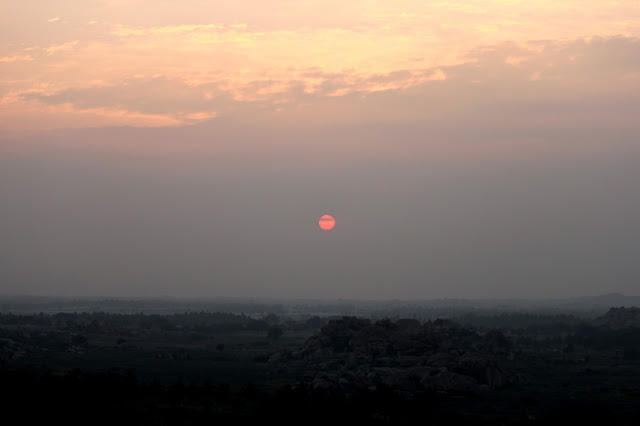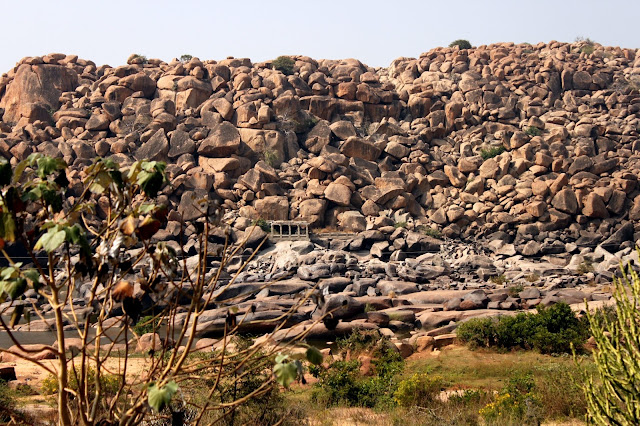The Vithala Temple represents one of the highlights of Hampi. Dedicated to Vishnu, the temple complex was built over many years around the 15th and 16th Century. The temple consists of several halls, pavilions and temples within the compound, that has a large gateway.
The stone Chariot located in the main courtyard is among the most well known images of Hampi to have emerged over the years. The Chariot has been carved out of a monolithic stone. Stone horses were present in the front of the Chariot, but were damaged and replaced with Elephants sometime during the course of the years.
A close up of the top of the Chariot reveals very fine carvings.
It is said that the wheels used to move in the past, but excessive movement resulted in damage to the chariot.
The main hall was being renovated, so entry was not allowed.
There are several halls around the complex, containing many pillars. Each pillar has four to six panels, and four faces. The Kalyana Mantapa (Marriage Hall) is said to contain 100 pillars.
The Vittala Temple is extremely well known for the 'Musical Pillars' fashioned out of single pieces of rock. Each of the pillars contains exquisitely carved statues and stories.
It appears that the some portions of the buildings need support, and are being renovated.
A close look at some of the sculptures.
The main sanctorium does not have a diety. You can go down a flight of dark stairs around the main structure. Streaks of light come in from gaps in the ceiling. It's extremely dark inside, below the floor level of the main chamber.
A view of intricately carved pillars.
Close up view of the Intricate carvings, from ceiling to floor.
The intricate 'little temples' took away my attention, like 'temples within temples', also seen in large numbers along the base of the Mahanavami Dibba.
The outer perimeter contains several towers and a host of smaller halls and temples.

As the sun sets, visitors begin to leave the Complex, leaving behind them quieter moments within the complex. Outside the complex, the rays of the setting sun light up the granite hallways of the remains of the Vittala Bazaar, yet another centre of trade between merchants from different countries.
The age old boulders seem to be quietly witnessing the passing centuries.
The walk from the Vithala Temple to the banks of the Tungabhadra River is a long one, through an interesting variety of ruins and rocks. The King's Balance is about 5 or 6 metres high. Legends say that the King used to weigh himself against gems on special occasions and distribute the gems to the priests.

The skeleton of a two-storeyed gateway building lies very close to the King's Balance.
The landscape got desolate as we walked along mud paths and rocks. A series of stone columns can be seen, which, we are told is the remains of a bridge that once spanned the river, joining Hampi and Anegundi. The construction of a 21st Century bridge was attempted, but it collapsed in 2009. Anegundi is reputed to be even older than Hampi, as an inhabited area.

Those who are familiar with Carnatic Classical Music would undoubtedly have heard of Purandaradasa. Back in the days before the TV era, All India Radio used to be our only source of musical exposure. From memory, the composer mentioned the highest number of times was certainly Purandaradasa. Considered the 'Grandfather of Classical Music', Purandaradasa is known for having composed 75,000 songs. (Source: Wikipedia). He lived in Hampi for many years, and is said to have spent much of his time composing songs in a stone building on the banks of the Tungabhadra River. The building is now known as the Purandaradasa Mantapa.

The trek continued on a base of solid rock, radiating an immense amount of heat, though it was the end of December. Several gateways, pillars and temples dot the area.
The Narasimha Temple (which I gathered from a map, since there are no signs) sits on the slopes of the hillock that climbs up sharply at this point.
After walking a few kilometres from the Vittala Temple, it is time for a short rest, and subsequently for an always welcome, 'Excuse Me' tender coconut drink.
The walk has been lovely, though. The landscape became seriously hot and rocky, with no end in sight.
The Varaha Temple, built in Vijayanagar style with an entrance and a courtyard, but now without any dieties, stands along the path towards the River.
Unexpectedly, a look towards the left reveals what would have been another marketplace. This area turns out to be Courtesan Street. The Varaha Temple is located at one end, near the river, while the more well known Achyuta Raya Temple is located almost a kilometer away at the other end, towards the town.
Shells of the traders shops are located along both sides of the long street. I was trying to count. How many Bazaar's have we seen so far?
A humble looking, unmarked temple is located nearby, dedicated to Vishnu, called the Rangatha Temple, also known as the Vishnu Temple. We did not go inside but chose to sit outside and gather our thoughts. I read later that there is a large statue of a reclining Vishnu inside the temple.
The dusty and rocky path winded on along the river. A sadhu was nonchalantly sitting on the blazing, hot rock. Ouch..!! He lifted his hand in a little gesture, and wished us well.
By then we had started wondering whether we have lost our way, and for how much longer might we continue to wander clueless among the boulders. Large boulders had suddenly appeared. At the end of a climb up narrow flights of stairs carved into the rock, past a few temples nestled between giant boulders, a Vijayanagar-era Bazaar like area suddenly appeared.
The double-storied stores looked very familiar. We've seen this recently, have we not?
I believe that not micro-managing travel has its plus points. Not walking around with a guide is great fun, adds significantly to the excitement. A lot more 'aha' moments are experienced, based on some basic reading about the monuments. So we had actually walked from the Vittala Temple, past the Tungabhadra River, and had reached the Virupaksha Bazaar opposite the Virupaksha Temple. Well..!!

Looking around, I saw a statue that I had read about, but had no idea where it was located. The Monolithic Bull. So, there it was, finally. I gravely and knowledgeably announced to the family "There's the Monolithic Bull." Like I was an authority on the monuments of Hampi. 'Oh', they said, with a fair amount of respect in their voices and looks. Actually, I had done a wee bit of virtual exploration, but the names of temples and places had only left my mind in a haze. A few names stood out. One of them was the 'Monolithic Bull', carved out of a massive rock. Being housed in a double storied pavilion, the Bull must be over 6 to 7 metres tall. Fortunately the attackers did not find any tusks and trunks to cut off. It looks strangely undamaged.
We walked along the Bazaar street, away from the Monolithic Bull, taking a few photographs along the way. As we reached the end, a quick look back showed the abandoned state of the once flourishing Vijayanagar Bazaar.
It's time for a late lunch by the River, passing the Virupaksha Temple complex on the way.
You may be interested in:
-=-=





















































